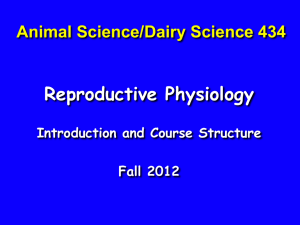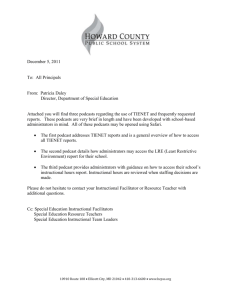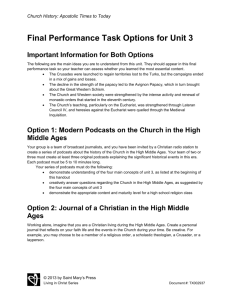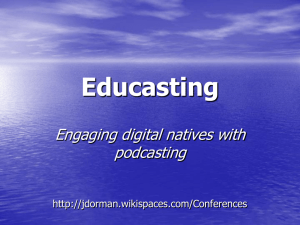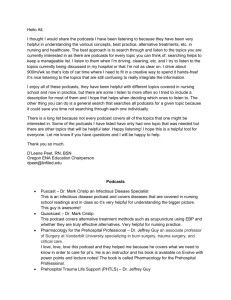Podcasting - Personal.psu.edu
advertisement
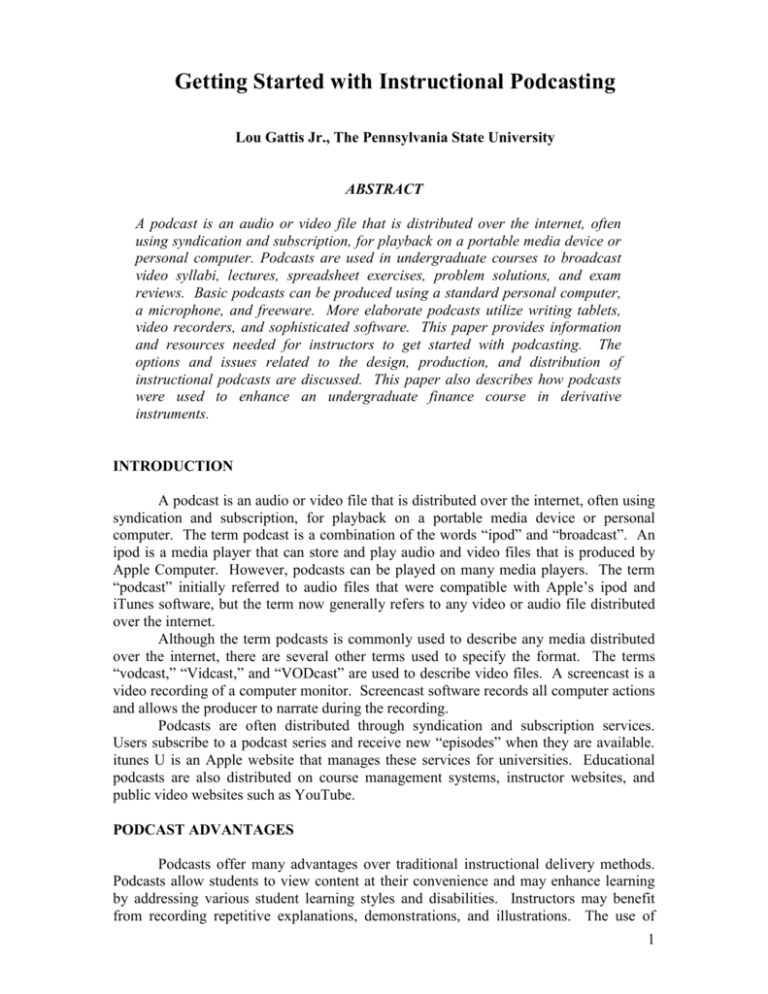
Getting Started with Instructional Podcasting Lou Gattis Jr., The Pennsylvania State University ABSTRACT A podcast is an audio or video file that is distributed over the internet, often using syndication and subscription, for playback on a portable media device or personal computer. Podcasts are used in undergraduate courses to broadcast video syllabi, lectures, spreadsheet exercises, problem solutions, and exam reviews. Basic podcasts can be produced using a standard personal computer, a microphone, and freeware. More elaborate podcasts utilize writing tablets, video recorders, and sophisticated software. This paper provides information and resources needed for instructors to get started with podcasting. The options and issues related to the design, production, and distribution of instructional podcasts are discussed. This paper also describes how podcasts were used to enhance an undergraduate finance course in derivative instruments. INTRODUCTION A podcast is an audio or video file that is distributed over the internet, often using syndication and subscription, for playback on a portable media device or personal computer. The term podcast is a combination of the words “ipod” and “broadcast”. An ipod is a media player that can store and play audio and video files that is produced by Apple Computer. However, podcasts can be played on many media players. The term “podcast” initially referred to audio files that were compatible with Apple’s ipod and iTunes software, but the term now generally refers to any video or audio file distributed over the internet. Although the term podcasts is commonly used to describe any media distributed over the internet, there are several other terms used to specify the format. The terms “vodcast,” “Vidcast,” and “VODcast” are used to describe video files. A screencast is a video recording of a computer monitor. Screencast software records all computer actions and allows the producer to narrate during the recording. Podcasts are often distributed through syndication and subscription services. Users subscribe to a podcast series and receive new “episodes” when they are available. itunes U is an Apple website that manages these services for universities. Educational podcasts are also distributed on course management systems, instructor websites, and public video websites such as YouTube. PODCAST ADVANTAGES Podcasts offer many advantages over traditional instructional delivery methods. Podcasts allow students to view content at their convenience and may enhance learning by addressing various student learning styles and disabilities. Instructors may benefit from recording repetitive explanations, demonstrations, and illustrations. The use of 1 podcasts may also free up class time include active and experiential exercises which have been shown to enhance learning. Connect to the Tivo and YouTube Generation The current YouTube and Tivo generation of students are comfortable with technology and expect content to be convenient and portable. A recent joke posted on a technology blog captures the feeling of the current generation-- “You might be in the Tivo generation if you sit in meetings and want to fast forward the presenter.” Podcasts allow students to shift the time and place of the learning for their own convenience. In short, podcasting allows students to Tivo your lectures for later playback, fast forward, rewind, and deletion. A recent survey found that the typical college-aged students view online videos at the highest rate among adults (Madden, 2007). Seventy-six percent of 18-29 year olds reported that they have watched videos online and twenty-two percent reported that they had watched educational videos. Enhance Learning Claxton and Murrell (1987) identified sixteen distinct learning styles. Davis (2001) suggests varying teaching methods, such as using podcasts, may address diverse styles and enhance learning. Podcasts are most affective for auditory and visual learners (Moses and Morales, 2006) and the pause and rewind podcast features may aid students with attention deficits. Lastly, podcasting frees up time for active learning exercises which has been shown to enhance learning (Davis, 2001). See Dale (2006) for a further discussion of podcasting and learning styles. Instructor Benefits Podcasts can reduce faculty workload by recording explanations, problem solutions, or entire lectures that can be viewed by multiple courses, sections, and students. The podcasting of long narratives and explanations allow instructors to have more meaningful and interesting classroom experiences. Instructor Concerns Two common podcasting concerns are the effort and resources that are needed to produce podcasts and the effects podcasts have upon student attendance. The level of effort and resources to produce podcasts will vary depending upon the podcast format. Basic podcasts that combine narration and PowerPoint can be done quickly using a standard personal computer and freeware. More elaborate podcasts that combine other elements, such as handwriting or animation, require the use of specialized hardware and software. However, many universities offer podcasting production studios that require no technological expertise from the instructor. A second concern is podcasting’s effect upon student attendance. Many argue that any technology that reduces the costs of non-attendance will surely reduce attendance. But attendance will largely depend on how podcasts are used. Podcasted classroom lectures that involve no student involvement will likely reduce attendance. Whereas the use of podcasts to preview lectures (a.k.a., precasts) may improve attendance. Several papers that document the initial experiences with podcasting show 2 little effect upon attendance (Meng, 2005 and Lane, 2006). Interestingly, while most students report that podcasts do not affect their attendance, students are concerned that it encourages other students to miss class. CHOOSING PODCAST CONTENT Holden and Westfall (2005) suggest that the most appropriate content to podcast is content this (1) does not require a symmetric flow of information between the instructor and students, (2) does not require instructor-student and student-student interaction, and (3) does not benefit from synchronous interaction (real-time), but (4) does benefit from the use of imagery and narration. Figure 1 categorizes various instructional delivery methods into four categories based on its symmetry and interactivity, and its synchronicity. Panels A and B contain active learning methods where information flow is two-way between instructors and teachers. Brainstorming, discussions, games, labs, and questioning usually take place in the classroom where instructors and students interact in real-time. Discussion boards and wikis are methods in which instructors and students interact in a delayed manner – which allows time for reflection and research. Panels C and D contain one-way instructional delivery methods. Panel D is one-way, real-time information flow from the instructor to the student that usually takes place in a classroom. Traditional lecturing is the most common methods of one-way, real-time instruction. Podcasts are in Panel C with other traditional one-way, time-shifted instruction such as books. Figure 1: Instructional Delivery Methods and Characteristics Active Learning High Symmetry and Interactivity Panel A: two-way, time-shift Panel B: two-way, real-time Discussion Board Wiki Brainstorming, Exercises Guided Discussion Game, Lab, Questioning, Interactive Lectures Panel C: one-way, time-shift Panel D: one-way, real-time Low Podcast Book/Article Notes Narrative Lecture, Twitter Problem Solution Demonstration Illustration Low High Synchronicity Podcasts are another one-way teaching method along side the traditional delivery methods of books and lectures. The advantage of podcasts over one-way, real-time methods (such as narrative lectures) is that students can time-shift the delivery-- just as Tivo allows viewers to time-shift television programming. In addition to adding viewing convenience, podcasts also allow students to rewind, fast-forward, and save the media. 3 The advantage of podcasts over other one-way, time-shifted methods (such as books) is that podcasts can combine imagery, speech, text, and motion. Unlike books, podcasts can be freely copied and distributed. The most appropriate content to podcast is that does not require two-way interaction and does not benefit from real-time occurrence. These instructional activities include defining, describing, narrating, explaining, categorizing, illustrating, demonstrating, and solving. This is not to suggest that lecturing is obsolete in undergraduate education. Some content benefits from live instruction, such as questioning and brainstorming. However, one-way, real-time instructional methods provide no convenience to the student and uses class time that could be used for active learning activities. Choosing the content is the first step in creating a podcast. Instructors should identify all one-way, real-time instruction in their course and determine if it could be more effectively delivered through a podcast (moving the content into Panel C) or made more interactive (moving the content into Panel D). Consumer research into preferences for live and recorded entertainment may provide suggestions for the remaining content in Panel D. Raghunathan and Corfan (2004) suggested that viewing a live broadcast was preferable if it was a shared experience. Frederick, Loewenstein, and O’Donoghue (2002) suggested viewers are impatient and want to see the event at its earliest showing. Vosgerau (2006) found that an important factor was whether or not the viewer considered the event to be indeterminate. Indeterminate (unscripted) events create excitement and preferences for live viewing even if the outcome is certain. Frijda et al (1989) suggest that this excitement may also excite action readiness as participants respond to threats and opportunities. This research may provide suggestions for making more effective lectures. A live lectures may be preferred by students if it is perceived to be unscripted, shared, and involve possible threats (i.e. cold calling) and opportunities (e.g., class participation credit). PODCAST Types The last several sections established that one-way communication that does not benefit from live interaction is the most amenable to podcast. This section describes various podcasts types and how they can be integrated into the curriculum. Introduction Podcasts Podcasts can provide current or prospective students an overview of course material, activities, and requirements. Examples of an introductory podcasts are video syllabi and general subject lectures. These are useful for students in course and instructor selection. Lecture Podcasts The podcasting of complete or partial lectures can be used by students who cannot attend a lecture or used to preview or review a lecture. Partial lecture podcasts can be used to preview lectures (Precast) or review past lectures (Postcast). A precast may provide students with reading assignments, key terms, and main points of the lecture. A 4 postcast may review the main points of the lecture or suggest additional resources such as articles, books, practice problems, or websites. Supplemental Podcasts Podcasts can supplement course curriculum with recorded demonstrations, illustrations, guest lectures, problem solving, interviews, and exam reviews. PODCAST FORMATS Podcast formats include audio recordings, live action videos, voice-overPowerPoint, and Screencasts. Audio Recordings Audio recordings are easy to produce and require only a standard PC and microphone. Table 1 shows the hardware and software requirements for each format. Audio recordings are also easily distributed and require little storage requirements. Specialized software can be used to edit and mix sound recordings. Audio recordings are most appropriate for content that does not benefit from imagery. Live Action Video Live action videos have been used to record lectures for many years to record classroom activities. A disadvantage of live action video is that it may be difficult to view instructor handwriting, illustrations and projections. It is also difficult to record student questions and answers. Live action video creates large files that may be difficult to store and distribute. Reimers and Singleton (2008) discuss how live action video recording were utilized in a resident finance course. Voice-over-PowerPoint Voice-over-Powerpoint (VOP) is the addition of narration to a standard PowerPoint presentation. VOP can be produced by either inserting audio files in each slide or by using presentation recording software such as Adobe Presenter to narrate the entire presentation. Screencasting Screen recording, which is also known as Screencasting, is the recording of computer screen images and speech. Screen recording software records specified screen areas and narration. The videos can then be converted into multiple file formats for distribution. Screencasts can combine any computer image-- PowerPoint, Excel, Internet Explorer, or tablet handwriting. Table 1: Format and Technology Format Hardware Audio Recording PC or Mac and Microphone Software Sound Recording and Editing (e.g., GarageBand (Mac), 5 Live Action Video Video Recorder/ Camcorder Voice over PowerPoint PC or Mac and Microphone PC or Mac and Microphone (Optional: External Writing Tablet or Tablet PC) Screen Recording Audacity (Mac/PC)) Video Editing (e.g., Apple iMovie (Mac), Adobe Premiere Elements (PC), Windows Movie Maker (PC)) Presentation Recorder (e.g., Adobe Presenter, Profcast) Screen Capture and Editing (e.g., Jing (PC/Mac), Camtasia Studio (PC), Adobe Captivate (PC), Snapz Pro X (Mac)) DISTRIBUTING PODCASTS Podcast files can be distributed through Apple’s iTunes U, course management software, the instructor website, or public file sharing sites. iTunes U is a website that stores and distributes podcasts. iTunes U allows students to subscribe to your course podcasts and automatically downloads new podcasts to students computer or portable media device. The disadvantages of iTunes U distribution are file type restrictions and students preference resistance to mix entertainment and educational media. Refer to the University of Missouri White Paper (2005) for a discussion of podcast subscription and syndication procedures. Podcast files can be uploaded to course management systems (CMS) such as Blackboard and ANGEL. The advantage of CMS distribution is that the podcasts are centrally located with other course content. The disadvantage of CMS distribution is storage size restrictions. EARLY PODCASTING EXPERIENCE This section discusses my experience incorporating podcasts into an existing, residential undergraduate course in financial derivatives. The course is an elective for finance seniors which focuses on the valuation and use of derivative instruments to speculate and hedge risks. I had previously taught the course for several years and received above average students evaluations. The three most common student criticisms of the class were the difficulty of material, the rapid pace of lectures, and need to demonstrate more problem solutions. I thought that podcasts could be used to move some lecture material from the classroom to podcasts and create problem solution podcasts. Getting Started I produced my first podcast in less than thirty minutes after downloading TechSmith’s Jing screen recording freeware. After opening the software, I specified that Jing record my whole screen, and then I recorded my voice and the screen as I viewed the presentation. Jing produced the podcast and provided a link where students go to play the podcast. Jing was easy and free, but it did not create a video file which I could save 6 and distribute. I downloaded a free trial of TechSmith’s Camtasia Studio which is a premium version of Jing that allows users to save podcasts in several standard file formats such as QuickTime Movies (MOV) and Windows Media Video files (WMV). After the free trial period, I purchased the Camtasia Studio and was ready to create course podcasts. To enhance my podcasts I also purchased an external PC microphone and a Wacom writing tablet. I now had the tools to create podcasts that recorded voice, computer screen images, and handwriting. Course Podcasts I produced my first course podcast midway through the semester. Several students asked the same question regarding a classroom PowerPoint presentation. So, I create a podcast that incorporated the PowerPoint slides and handwriting just as I do in the classroom (Figure 3). I opened Camtasia Studio and specified that it record the entire screen. After launching the presentation, I right-clicked the mouse selected a pointer to handwrite over the presentation. I started recording and began to write on the slides (using the Wacom tablet) and narrate. I reviewed the recording for accuracy and then saved the recording as a Windows Media Video (WMV) file. I used all default settings and the podcast was created in several minutes. Camtasia Studio created a 10-minute, 40-megabyte file. I found that disabling the automatic focusing feature option and reducing the video size to 640x480 created a ten megabyte file (one-megabyte per minute). I uploaded the video to the course management system and sent an announcement to students. Over the next several weeks I created several more 5-10 minute podcasts of PowerPoint presentations. Figure 3: PowerPoint and Handwriting Podcast Prior to the midterm exam I create a podcast demonstrating how to solve the practice exam by combining Microsoft Word and Corel Painter Essentials (Figure 4). I opened the Word document and positioned the Corel Painter window just below the exam question. I then recorded my voice and handwritten solution to the problem. After each problem I paused the recording to clear the Painter and advance to the next exam 7 problem. The final podcast was 40-minutes long and 40-megabytes. I did notice that after about 20 minutes the audio fell behind the video in the podcast. In future podcasts, I broke up the podcasts into 5-10 minute segments to fix this problem which was apparently caused by my laptop’s slow processing speed. I also found that smaller podcasts (about 5-10 minutes) are easier to edit. Later I produced podcasts that combined Excel exercises, internet applications and other specialized software applications. A total of 16 podcasts were created for the course. Figure 4: Word, Paint and Handwriting Podcast Student Feedback Ninety-eight students were enrolled in the class across three sections and I tracked student podcasts viewing. A total of 91 out of 98 students accessed the podcasts with a median of 10 visits per student and a range of 1-96 visits per student. I also surveyed students toward the end of semester. Students unanimously stated that the podcasts were useful and they wanted more. Students also suggested that they prefer shorter podcasts and prefer delivery through the course management system. The university administered student evaluations of the course and instructor were significantly higher than previous semesters and many students wrote positive comments about the podcasts. SUMMARY Podcasts are an easy way to deliver one-way, time-shifted communication to students. Podcasts have an advantage over tradition one-way delivery methods because podcasts combine speech and imagery to students in a portable format that can be easily stored, rewound, and fast-forwarded. Podcasts may also address different learning styles and help student with attention disorders. Screencasts are particularly effective at combining computer imagery, handwriting, and speech in a relatively small file. Podcasts can increase student satisfaction and instructor evaluations. 8 REFERENCES Campbell, G. “There’s Something in the Air: Podcasting in Education,” Educause Review, 2005, Vol 40, No 6, 33-46. Claxton, C. S., and P. H. Murrell. Learning Styles: Implications for Improving Educational Practices, ASHE-ERIC Higher Education Report, 1987, No 4, Washington, DC. Dale, C., “Strategies for Using Podcasting to Support Student Learning,” 2007, Journal of Hospitality, Leisure, Sport and Tourism Education, Vol 6, No 1, 49-57. Davis, B. G. Tools for Teaching, 2001, John Wiley & Sons, Inc. Eisenberg, A. “What Did the Professor Say? Check Your iPod,” New York Times Online, December 9, 2007. Frederick, S. G. Loewenstein and T. O’Donoghue. “Time Discounting and Time Preference: A Critical Review,” Journal of Economic Literature, 2002, Vol 40, June, 351–401. Frijda, N. H. P. Kuipers, and E. Schure. “Relations Among Motion, Appraisal, and Emotional Action Readiness,” Journal of Personality and Social Psychology, 1989, Vol 57 (August), 212–28. Holdem J. T. and J. Westfall. An Instructional Media Selection Guide for Distance Learning Second Edition, 2006, United States Distance Learning Association (USDLA). Lane C. “Podcasting at the UW: An Evaluation of Current Use,” 2006, University of Washington Lum, L. “The Power of Podcasting,” Diverse Issues in Higher Education, 2006, Vol 23, No 2. Madden, M. “Online Video,” Pew Internet & American Life Project, 2007, http://www.pewinternet.org/pdfs/PIP_Online_Video_2007.pdf. Meng, P. “Podcasting and Vodcasting, A White Paper,” 2005, University of Missouri Messingham, P. and T. Herrington. “Does Attendance Matter? An Examination of Student Attitudes, Participation, Performance and Attendance,” Journal of University Teaching and Learning Practice, 2006, Vol 3, No 2. Moses, J. S. and C. Morales. “Podcasting: Recording, Managing, and Delivering the Classroom Experience,” 2006, Educause Evolving Technologies Committee, The University of Chicago. Notess, G. R. “Casting the Net: Podcasting and Screencasting,” Online, 2005, Vol 29, No 6. 9 Peterson, E. “Incorporating Screencasts In Online Teaching,” The International Review in Open and Distance Learning, 2007, Vol 8, No 3. Raghunathan, R. and K. P. Corfman. “Is Happiness Shared Doubled and Sadness Shared Halved? Social Influence on Enjoyment of Pleasant and Unpleasant Consumption Experiences,” 2004, Working Papers, University of Texas, Austin. Reimers. J. and J. C. Singleton. “Podcasting Finance Classes: Some Early Experiences”, Journal of Financial Education, 2008, Vol 34, Spring. Sidman, J. “Wired for Safety, Late-night Snacks.” USA Today Online, August 27, 2008. Vosgerau, J., K. Wertenbroch, and Z. Carmon. “Indeterminacy and Live Television,” Journal of Consumer Research, 2006, Vol 32, No 4, 487-495. 10
